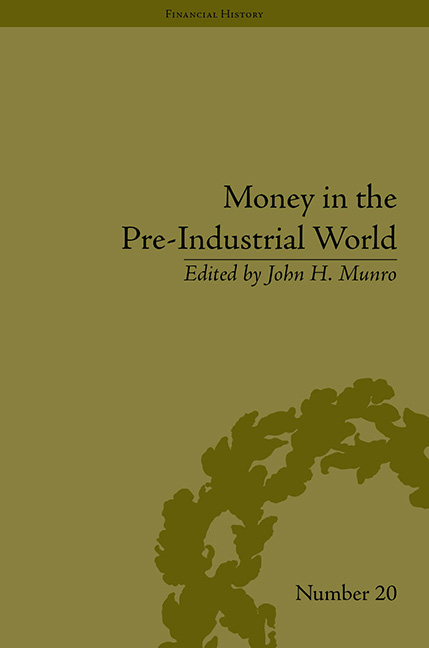Book contents
- Frontmatter
- CONTENTS
- List of Figures and Tables
- List of Contributors
- Introduction
- 1 The Technology and Economics of Coinage Debasements in Medieval and Early Modern Europe: with Special Reference to the Low Countries and England
- 2 From Aurelian to Diocletian: Financing Imperial Recovery by Coinage Debasements and Fiduciary Currencies
- 3 The Making of a Gold Standard: The Ducat and its Offspring, 1284–2001
- 4 Debasement of the Coinage and its Effects on Exchange Rates and the Economy: in England in the 1540s, and in the Burgundian-Habsburg Netherlands in the 1480s
- 5 The Amsterdam Wisselbank's Innovations in the Monetary Sphere: The Role of ‘Bank Money’
- 6 Silver in England 1600–1800: Coinage Outputs and Bullion Exports from the Records of the London Tower Mint and the London Company of Goldsmiths
- 7 The Burdens of Tradition: Debasements, Coinage Circulation and Mercantilist Public Policy Debates in Seventeenth-Century Aragon
- 8 Money or Export Commodity for Asia? American Silver in the Markets of Mexico, Castile and Amsterdam from the Sixteenth to the Eighteenth Century
- 9 Cacao Beans in Colonial México: Small Change in a Global Economy
- 10 Precious Metals, Debasements and Cowrie Shells in the Medieval Indian Monetary Systems, c. 1200–1575
- Notes
- Index
10 - Precious Metals, Debasements and Cowrie Shells in the Medieval Indian Monetary Systems, c. 1200–1575
- Frontmatter
- CONTENTS
- List of Figures and Tables
- List of Contributors
- Introduction
- 1 The Technology and Economics of Coinage Debasements in Medieval and Early Modern Europe: with Special Reference to the Low Countries and England
- 2 From Aurelian to Diocletian: Financing Imperial Recovery by Coinage Debasements and Fiduciary Currencies
- 3 The Making of a Gold Standard: The Ducat and its Offspring, 1284–2001
- 4 Debasement of the Coinage and its Effects on Exchange Rates and the Economy: in England in the 1540s, and in the Burgundian-Habsburg Netherlands in the 1480s
- 5 The Amsterdam Wisselbank's Innovations in the Monetary Sphere: The Role of ‘Bank Money’
- 6 Silver in England 1600–1800: Coinage Outputs and Bullion Exports from the Records of the London Tower Mint and the London Company of Goldsmiths
- 7 The Burdens of Tradition: Debasements, Coinage Circulation and Mercantilist Public Policy Debates in Seventeenth-Century Aragon
- 8 Money or Export Commodity for Asia? American Silver in the Markets of Mexico, Castile and Amsterdam from the Sixteenth to the Eighteenth Century
- 9 Cacao Beans in Colonial México: Small Change in a Global Economy
- 10 Precious Metals, Debasements and Cowrie Shells in the Medieval Indian Monetary Systems, c. 1200–1575
- Notes
- Index
Summary
How did a pre-modern government sustained largely by agricultural revenue maintain a viable monetary system when it lacked indigenous sources of precious metal? Importation was key, but supply constraints induced different responses. This chapter examines the early medieval Indian context, where both debasement and coinage substitutes were attempted. A case study is examined: the coastal Bengal sultanate, which maintained for almost four centuries a monetary system based on imports of silver and cowrie shells. This system is contrasted with the monetary situation in the inland Delhi sultanate, which progressively lost its capacity to sustain precious metal coinage, coincident with its loss of sovereignty over coastal connections.
India's Monetary Context
To summarize several millennia of monetary history for a place as populous and diverse as India is manifestly impossible. Yet there is still considerable value in providing a ‘gloss’ of these pre-modern Indian monetary issues in order to compare the Indian experience with pre-modern European monetary history. As in pre-modern Europe, the monetary systems of the various Indian economies were dependent on the highly variable availability of precious metals for coinage. For most of the pre-modern era, however, western European countries differed in experiencing a loss of coinage metals through export beyond their continent. Indeed, for much of this era, European commentators have commonly identified India as the ultimate destination for European precious metals, through the nexus of international trade with intervening regions (such as the Levant). Within India, however, there is no such overall concern with a slow drainage of metals elsewhere. Rather, the ever-present promise of imported metals (to the extent that a polity was linked into external trade routes) is a constant refrain in Indian monetary history.
Situated in a distinct geological province of great antiquity, the Indian subcontinent has been blessed with significant sources of gold mineralization (narrowly distributed in veins in the south and alluvially in the north-east), but only modest sources of silver (mostly as a minor component of lead/zinc ores in Rajasthan) and plentiful copper deposits (moderately well-distributed geographically). The prolific and renowned issue of a silver fiat coinage by the ancient Mauryan Empire (fourth–second centuries bc), which was probably based on indigenous silver sources, proved to be unsustainable because those sources were ultimately exhausted.
- Type
- Chapter
- Information
- Money in the Pre-Industrial WorldBullion, Debasements and Coin Substitutes, pp. 163 - 182Publisher: Pickering & ChattoFirst published in: 2014



